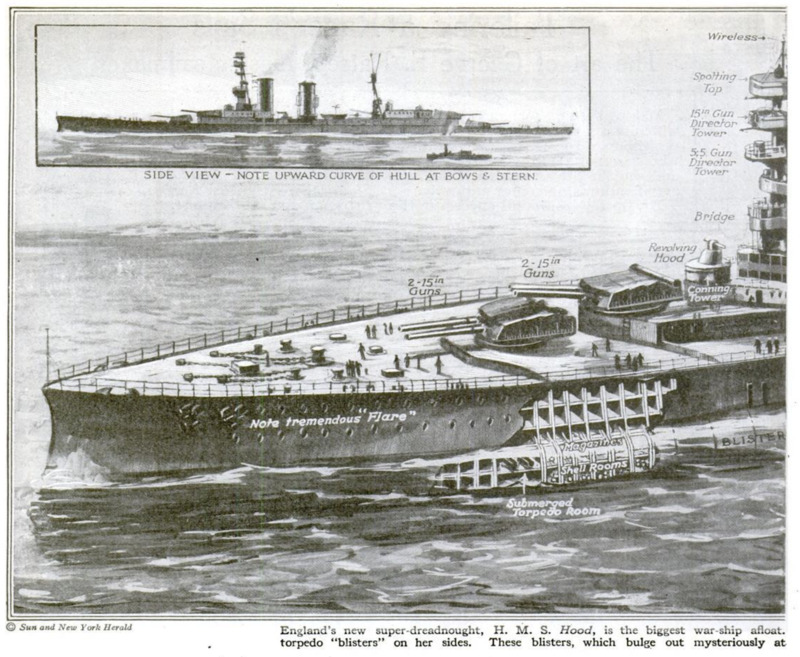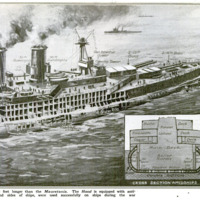H. M. S. Hood
Item
-
Title (Dublin Core)
-
H. M. S. Hood
-
Article Title and/or Image Caption (Dublin Core)
-
The Greatest Sea-Fighter of Them All
-
Caption: England's new superdreadnought, H. M. S. Hood, is the biggest war-ship afloat. She is 70 feet longer than the Mauretania. The Hood is equipped with anti-torpedo "blisters" on her side. These blisters, which bulge out mysteriously at bottom and sides of ships, were used successfully on ships during the war
-
extracted text (Extract Text)
-
ENGLAND'S new super-dreadnought, H. M. S. Hood,
which cost $80,000,000, is the result of lessons
learned in the recent war. She has greater displacement
than any of her older sisters, and she is so beamy that
locks and many docks will have to be widened to accom-
modate her. Both of these features are due to increased
protection both above and below water. The battle of Jut-
land proved this necessary, even at some sacrifice in speed.
‘Below-water protection is provided for by “blistering.”
The “blister” is a mysterious bulge
at the sides and bottom of a ship to
protect her from torpedo wounds.
Some of England's battleships were
thus “blistered” during the war.
In spite of the Hood's immense size,
a very large part of the hull is covered
with heavy armor. On the turret roofs
the armor is of double thickness to
allow for the effect of plunging fire,
which proved so destructive in the first
North Sea engagement. Everything
has been done to secure the utmost
strength and resisting power. In fact,
the Hood is better equipped to resist
attack from any weapon known to
naval science than any war-ship afloat.
The Hood could hardly be sunk by
torpedoes, according to Sir Eustace
Tennyson-d’Eyncourt, Director of Naval Construction
at the British Admiralty.
The Hood carries eight fifteen-inch guns, mounted. in
such a manner as to permit them to be elevated through
an angle of thirty degrees, thus increasing their range to
forty thousand yards. The Germans were the first to
resort to the elevation of
guns so as to increase |
their range—this before |
the war. There are sev-
eral five-inch guns and a |
few anti-aircraft guns.
An elaborate system of
fire control known as
director firing has been
installed. Itineludesthe
main director station on |
the tripod foremast and
a long-base range-finder
in the gunnery control.
No official details of the
torpedo armament are
available,but the present
tendency is to revert to
the above-water position
for torpedo-tubes.
The Hood is 860 feet |
over all.
-
Language (Dublin Core)
-
eng
-
Date Issued (Dublin Core)
-
1920-08
-
pages (Bibliographic Ontology)
-
30-31
-
Rights (Dublin Core)
-
Public Domain (Google digitized)
-
Archived by (Dublin Core)
-
Filippo Valle
-
Alberto Bordignon (Supervisor)
 Popular Science Monthly, v. 97, n. 2, 1920
Popular Science Monthly, v. 97, n. 2, 1920





